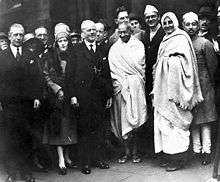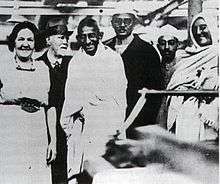Mirabehn

Madeleine Slade (Mirabehn) (22 November 1892 – 20 July 1982), daughter of the British Rear-Admiral Sir Edmond Slade, was a British woman who left her home in Britain to live and work with Mohandas Gandhi, the leader of the Indian independence movement. She devoted her life to human development, the advancement of Gandhi's principles and the freedom struggle in India. In doing so, Gandhi gave her the name Mirabehn, after Meera Bai, the great devotee of Lord Krishna.
Early life
Mirabehn was born into an aristocratic British family in 1892. Her father, Sir Edmond Slade was an officer in the Royal Navy who was posted in her early years as the Commander-in-Chief of the East Indies Squadron, later becoming director of the Naval Intelligence Division.[1] She spent much of her childhood with her maternal grandfather who owned a large country estate and was from an early age a nature and animal lover.[2]
The other great passion of the young Mirabehn was the music of Ludwig van Beethoven. She took to the piano and concerts and even went on to become a concert manager. In 1921 she even arranged for a German conductor to lead the London Symphony Orchestra in concerts featuring Beethoven and helped bring about an end to the British boycott of German musicians that followed the First World War.[1]
She also visited Vienna and Germany to see the places where Beethoven had lived and composed his music and she read extensively on him. She read Romain Rolland's books on Beethoven and later sought and met with him at Villeneuve, where he was then living. During this meeting, Rolland mentioned about a new book of his called Mahatma Gandhi which she had not read then. Rolland described Gandhi as another Christ and as the greatest figure of the 20th century.[1][2] On her return to England she read Rolland's biography of Gandhi and the book convinced her to become a disciple of the Mahatma. She wrote to Gandhi asking him if she could become his disciple and live with him in Sabarmati Ashram. Gandhi replied, inviting her over but also warning her of the ascetic discipline of the Ashram's inmates.[3] Having made her decision, she went about training herself for all the demands of an ascetic's life in India including vegetarianism, spinning and teetotalism. That year in England, she subscribed to Young India and spent a part of her time in Paris reading the Bhagvad Gita and some of the Rigveda in French.[4]
Life in India and role in the freedom struggle
She arrived in Ahmedabad on 7 November 1925 where she was received by Mahadev Desai, Vallabhbhai Patel and Swami Anand. This was the beginning of her stay in India that lasted almost thirty-four years.[4] Mirabehn during her stay in India went to the Gurukul Kangri to learn Hindi. Thereafter she went to Bhagwat Bhakti Ashram of Rewari established by Swami Parmanand Maharaj to be blessed by him. She also wrote to Mahatma Gandhi about her experiences there in Bhagwat Bhakti Ashram.

Mirabehn's stay in India coincided with the zenith Gandhian phase of the freedom struggle. She accompanied Gandhi and others to the Round Table Conference in London in 1931. While on their way back from London, Mirabehn and Gandhi visited Rolland for a week and as they took his leave, Rolland gave her a book on Beethoven which he had written while she was in India. In 1960 as she began to read it, it convinced her to move to Austria and spend her remaining days in the land of Beethoven's music.[1] The resumption of the Non Cooperation Movement in 1931 saw her being imprisoned during 1932–33.[5]
To plead India's case she also went abroad meeting, among others, David Lloyd George, General Smuts and Winston Churchill, and visited the United States, where she met Mrs. Roosevelt at the White House. Mirabehn also took an active interest in the establishment of the Sevagram Ashram and worked among the people of Orissa to resist any potential Japanese invasion non-violently in the beginning of 1942. She was arrested and detained with Gandhi in the Aga Khan Palace, Pune, from August 1942 to May 1944 where she saw Mahadev Desai and Kasturba Gandhi pass away. She was also a witness to the Simla Conference and the Cabinet Mission, the Interim Government and the Constituent Assembly, the Partition of India and the assassination of Mahatma Gandhi.
Post-independence life in India
After her release from the Aga Khan Palace, with Gandhiji's permission, she established the Kisan Ashram at a site near Roorkee. The land was donated to her by the local villagers. After Independence, she established the Pashulok Ashram near Rishikesh and a settlement named Bapu Gram and the Gopal Ashram in Bhilangana in 1952.[4] She took to dairying and farming experiments in these ashrams and also spent a while in Kashmir. During the time she spent in Kumaon and Garhwal she observed the destruction of the forests there and the impact it was having on floods in the plains. She wrote about it in an essay titled Something Wrong in the Himalaya but her advice was ignored by the Forest Department. In the 1980s, these areas witnessed a large Gandhian environmental campaign to save the forests called the Chipko Movement.[6]
She returned to England in 1959. In 1960, she relocated to Austria and spent twenty-two years in Vienna, where she died in 1982.
She was awarded India's second highest civilian honour, the Padma Vibhushan in 1981.
Books by Mirabehn
Mirabehn's autobiography is titled The Spirit's Pilgrimage. She also published Bapu's Letters to Mira and New and Old Gleanings.[7][8] At the time of her death she had also left behind an unpublished biography of Beethoven, the Spirit of Beethoven.[9]
In popular culture
- Actress Geraldine James portrayed her in Richard Attenborough's film, Gandhi, which premiered several months after Madeleine Slade's death in 1982.
- Sudhir Kakar's Mira and the Mahatma is a fictional account on the relationship between Gandhi and Madeleine as his disciple Mirabehn.[3]
Bibliography
- Spirits Pilgrimage, by Mirabehn. Great River Books. 1984. ISBN 0-915556-13-8.
- New and old gleanings, by Mirabehn. Navajivan Pub. House. 1964.
See also
References
- 1 2 3 4 Lindley, Mark. "Mirabehn, Gandhi and Beethoven". Academia.edu.
- 1 2 Gupta, Krishna Murti. "Mira Behn: A friend of nature".
- 1 2 Singh, Khushwant (1 October 2005). "IN LOVE WITH THE MAHATMA". The Telegraph.
- 1 2 3 "Associates of Mahatma Gandhi, Mirabehn".
- ↑ "WOMEN AND INDIA'S INDEPENDENCE MOVEMENT".
- ↑ Langston, Nancy. "Significant Women in Forestry".
- ↑ "Mira Behn, disciple of Mahatma Gandhi". indiavideo.org.
- ↑ "Books by Mirabehn". amazon.com.
- ↑ "The making of Mirabehn". The Hindu. 24 September 2000.
- Letters to Mirabehn, by Mahatma Gandhi. # Greenleaf Books. 1983. ISBN 0-934676-53-4.
External links
| Wikimedia Commons has media related to Madeleine Slade. |
- Biography from mkgandhi.org
- In the company of Bapu: In the just-released Mira & the Mahatma, psychoanalyst Sudhir Kakar delves into the complex relationship between a remarkable Englishwoman and the man she worshiped – The Telegraph
- Video interview with Mirabehn. A description of the video is here.